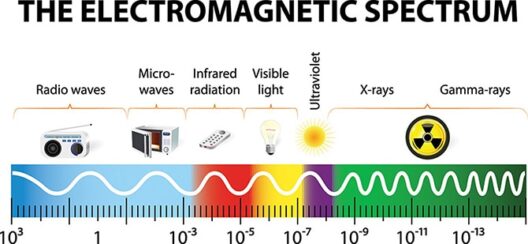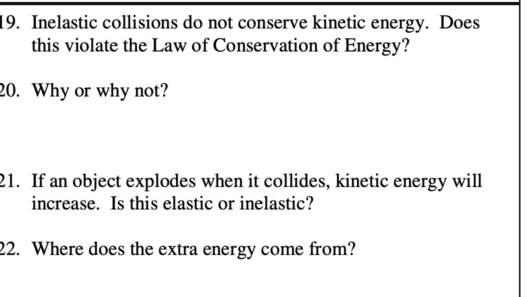Kinetic energy, as a fundamental aspect of physics, refers to the energy that an object possesses due to its motion. In classical mechanics, the principle of conservation of energy dictates that the total energy within an isolated system remains constant. However, when examining kinetic energy specifically, the query arises: does kinetic energy need to be conserved in all directions? To thoroughly explore this concept, one must delve into the nuances of kinetic energy, the circumstances under which it is conserved, and the implications of its directionality.
At its core, kinetic energy (KE) is defined by the equation KE = 1/2 mv², where m represents mass, and v denotes velocity. This scalar quantity depends on the square of the velocity, which inherently implies that it is always non-negative regardless of the direction of motion. Understanding kinetic energy requires an appreciation of both vector and scalar quantities, as motion is described in terms of vectors, but energy is a scalar. This distinction is crucial when discussing conservation laws.
Initially, one must recognize the conditions which lead to the conservation of kinetic energy. In elastic collisions—where both momentum and kinetic energy are conserved—objects rebound off each other without any loss of kinetic energy. For example, consider two billiard balls colliding on a table. Their interactions exemplify an elastic collision where kinetic energy is redistributed rather than diminished. Yet, this conservation is not universal; in inelastic collisions, kinetic energy transforms into other forms of energy, such as thermal energy or sound. Hence, while kinetic energy can be conserved in specific scenarios, it does not retain its conservation in all interactions, nor does it uphold in every dimension or direction.
The dimension of motion is of particular significance. In two-dimensional systems, where an object moves along both the x and y axes, the effectiveness of kinetic energy conservation can vary across these axes. During a perfectly elastic collision, one might find that the components of velocity along each direction change, yet the total kinetic energy remains constant. However, if the interaction is inelastic, one loses kinetic energy in one or both dimensions due to energy dissipation, highlighting that conservation is not guaranteed directionally, especially in complex, multi-directional interactions.
Furthermore, the concept of conservation of kinetic energy becomes embroiled with external forces. If an external force acts on a system—such as friction or gravity—the system is no longer closed and, consequently, does not conserve kinetic energy in all directions. For instance, consider a sled sliding down a hill; gravitational potential energy converts into kinetic energy as it descends. However, the frictional force opposing motion dissipates energy, causing kinetic energy not to remain constant throughout the sled’s journey.
The ramifications of kinetic energy not being conserved in all directions extend beyond theoretical physics; they permeate various practical applications. In engineering, for instance, the design of vehicles must account for energy dissipation in crashes. Understanding where energy is lost during a collision can enhance safety features. Similarly, in the realm of sports, athletes utilize knowledge of kinetic energy and its conservation to improve performance. A soccer player, for example, angles their body to maximize kinetic energy transfer, while also being cognizant that some energy will be dissipated through air resistance and friction with the ground.
The importance of context cannot be overstated in discussions of kinetic energy. The interpretation of kinetic energy conservation also feeds into discussions of energy efficiency and sustainability. In developing renewable energy technologies, engineers design systems to maximize the conversion of potential energy into kinetic energy with minimal losses. Wind turbines, hydroelectric plants, and solar panels are all predicated on understanding how energy shifts from one form to another, and in these considerations, directional aspects of energy flow play vital roles.
Mathematically, kinetic energy analysis often intersects with vector calculus, where motion is decomposed into components along different axes. Such decomposition allows for a detailed assessment of how velocity changes across parameters. Mathematical tools such as the dot product and vector resolution can provide insight into kinetic energy distribution. A deeper appreciation for this mathematical framework can enhance comprehension of why kinetic energy may vary in different dimensions and how it translates in real-world situations.
This interplay between theoretical physics and tangible outcomes fosters an intricate dialogue around kinetic energy conservation. Educational systems must impart this knowledge to future generations, emphasizing critical thinking and conceptual clarity regarding the conservation laws under various conditions. Workshops, seminars, and experiments can enhance engagement with concepts such as momentum and energy transformations, paving the way for a substantive understanding of these principles.
In summary, while kinetic energy can be conserved in specific conditions, particularly during elastic collisions, it does not inherently hold true in all directions or interactions. External influences and the vectorial nature of motion complicate energy conservation. The implications for engineering, sports, and sustainable practices highlight the necessity of understanding the nuances of energy transfer and conservation. Thus, educators and practitioners alike must foster a rich understanding of kinetic energy and its behaviors, preparing individuals to navigate the complex landscape of energy dynamics in their respective fields.







